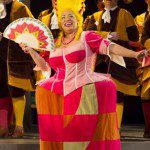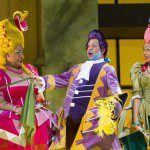WNO’s ‘Cinderella’: a Long, Fast-Paced Opera That Retains Its Loveliness
By • May 21, 2015 0 2184

There is often comedy in operas, but there are few comic operas, certainly not the kind that Giaochino Rossini put together—“The Barber of Seville,” his first success, and “Cinderella” or “La Cerentola”, which he wrote in 1816, on the heels of the success of “Seville.”
Both operas are highly entertaining, and often laugh out loud funny, and both might be called the opera versions of cinematic rom-coms, in the sense that the action is spurred by romance and love, the idyllic kind that overcomes all obstacles as in the case of “Cinderella”.
“Cinderella,” sourced from a French fairy tale by Charles Perrault, which may account for its very likeable lightness, as opposed to the often grim output of the brothers Grimm. As a generic subject—a lovely young girl loses her beloved father and is pushed into the role of a dirt-sweeping servant girl, run ragged by haughty, cruel in-laws until her essential goodness and good looks triumph to snare a prince in search of a princess.
The images and themes of “Cinderella” are never far from the public eye. There have been ballets, fictional stories, television and stage musicals, and a classic Disney cartoon complete with a pumpkin that turns into a carriage and beloved mice and a fairy godmother.
This year, the Disney folks re-visited the story again in a big box-office live action film, directed by Shakespearean great Kenneth Branagh, no less. The story of a virtuous princess, a handsome prince, and noteworthy villains never seems to lose its appeal.
Now, we have the Washington National Opera ending its 2014-2015 season with a spritely, lively, full-of-eye-candy and blessed with musical and vocal bravado production of Rossini’s enduring success. It runs through May 21 at the Kennedy Center Opera House.
Purists might cringe at this thought, but this is one of those operas and productions that’s a crowd pleaser for the whole family—for fussy, comforted boomers, for millennials who get the jokes and for budding princesses dressed up for the occasion by their moms. A larger audience of thousands will get to view the production when it’s simulcast for free at Nationals Park May 16 as part of M&M’s “Opera in the Outfield.”
There are even mice, a half dozen or so of them, the friends of the princess-in-waiting, scurrying about, consoling friends and protectors of Cinderella, who dotes on them. This is an exercise in stage whimsy, and for those with a low tolerance for whimsy … well, too bad.
This is not quite the same old story—there’s no lost slipper (a piece of mother’s jewelry serves the same function), no evil stepmother, but there are two spectacular evil stepsisters in high-rise, high-color wigs, given full-bodied passion, nastiness, humor and drama by Domingo-Cafritz Young Artists Soprano Jacqueline Echols as Clorinda and the mezzo-soprano Deborah Nansteel as Tisbe.
“Cinderella” should be one of those accessible (as in “Carmen” or “The Magic Flute”) operas for people who supposedly don’t like operas. It’s practically a textbook case for opportunities to admire and be in a little awe of music full of pitfalls and difficult to sing. Rossini wrote “Cinderella” at top speed , and the music seems to have a little breathless quality to it, it is as if the orchestra were part of a running marching band. It’s not music or singing made for contemplation, including two bravura sections which end in characteristic Rossini crescendos, as six characters pass the vocal ball back and forth, sometimes seeming to levitate.
Aside from the sisters—and an energetic Simone Alberghini as Dandini a fake prince—it’s the Italian baritone Paolo Bordogna who has the showiest role as the wicked stepfather modestly named Don Magnifico. He sings his arias and words faster than a machine gun, puffs himself up like a red-faced puffin and struts like a short man trying to be tall.
Goodness wills out, but it has a tougher go of it in terms of the music, which rises to inspiration, but not necessarily and perforce to singing that makes you jump out of your seat. What rising star mezzo soprano Isabel Leonard manages to make of the part of Angelina (as in Cinderella) is to give the part and the music a great deal of warmth and grace, if not drama, which is just so, given the nature of the character. It’s really hard to bring purity and goodness to great musical heights—Cinderella is, after all, the most forgiving creature on earth, which foregoes a political career. But, in the end, she shines too, as does Russian tenor Maxim Mironov as Don Ramiro, the prince.
When the sisters and Don Magnifico and Dandini are on stage, the production acquires a brash stylish, almost tongue-in-cheek knowingness to it, but when Cinderella takes center stage, it becomes quieter, an overlay of some lovely remnant of the story whence it came.
For an opera that has so much vocal virtuosity in it, the first act is something of a haul at a hefty two hours. But conductor Speranza Scappuci and director Joan Font pull together to keep things at a pace where the hours, although they do not pass swiftly, pass engagingly.
- Deborah Nansteel as Tisbe. | Scott Suchman for WNO






